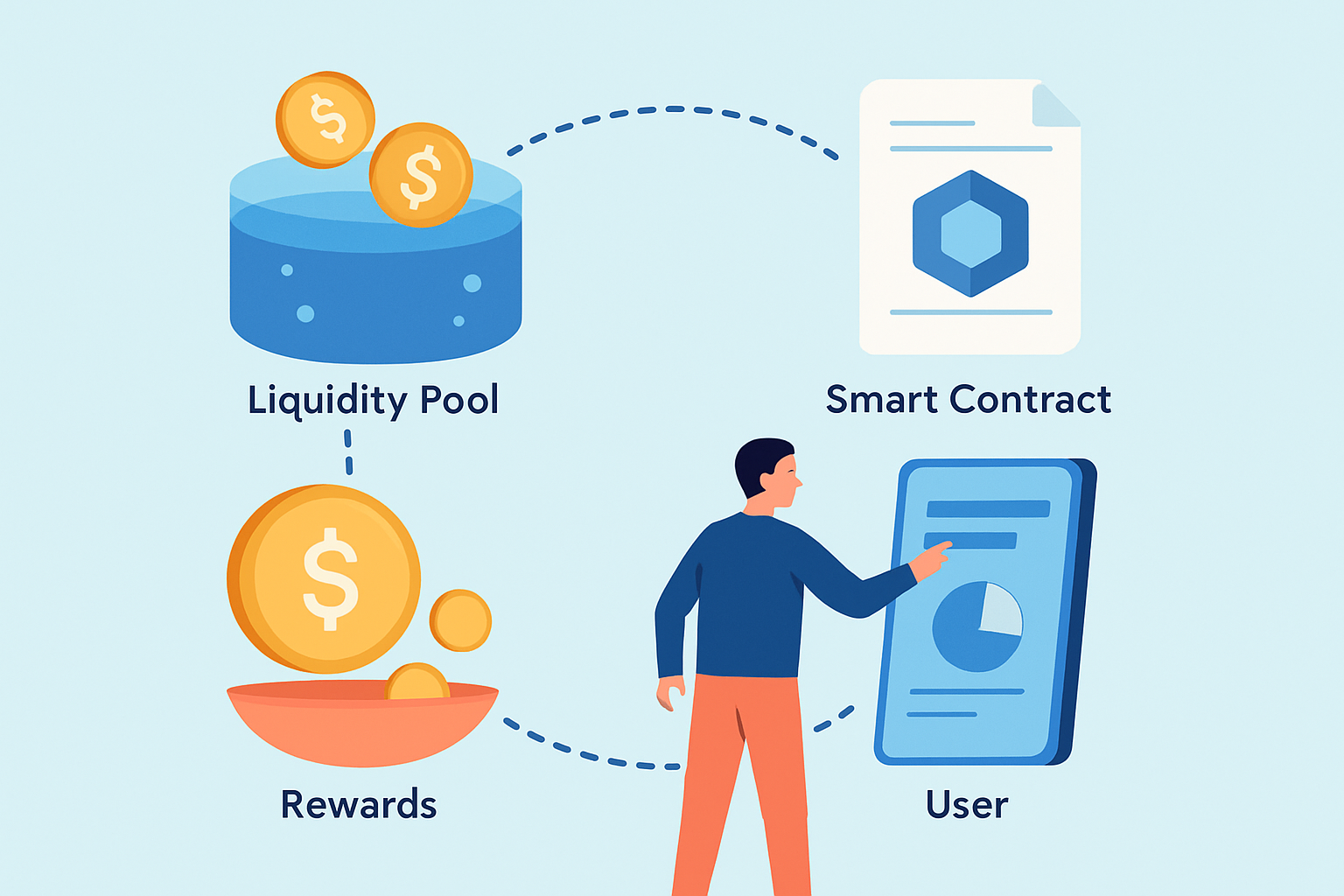Yield Farming Guide for DeFi Beginners


Yield farming has truly shaken up how people earn passive income in decentralized finance. This yield farming guide is here to give beginners essential insights and tips they’ll need to dive into yield farming with more confidence, understand its perks, and keep a steady grip on the risks along the way.
What Is Yield Farming A Beginner’s Guide That’ll Get You Started
Yield farming is a bit like the wild west of DeFi where people lend or stake their crypto assets hoping to rake in rewards or interest. It all kicked off with Ethereum-based protocols and really stands apart from your usual investing or staking by actively hunting for the best returns across various platforms, thanks to smart contracts working their magic behind the scenes
- Liquidity providers chip in tokens to pools, making decentralized trading and borrowing not just possible but pretty seamless.
- Participants typically rake in rewards, usually paid out in the platform’s native token or a slice of the fees collected.
- Knowing the difference between APR (simple interest) and APY (compound interest) is a must-have skill to get a clear picture of your real returns.
- Impermanent loss creeps in when token prices diverge after you deposit, which can put a dent in your profits.
- Users need to keep a wary eye on their security as smart contracts take care of farming automation.
What Goes Down in Yield Farming
Yield farming basically involves locking up your crypto assets into liquidity pools inside DeFi protocols. These pools act like the grease that keeps trades or loans running smoothly, generating fees that are then passed back as rewards to liquidity providers.
Pick a reliable yield farming platform that suits your risk appetite and supports the assets you want to work with.
Add liquidity by tossing your crypto tokens into the platform’s liquidity pool—think of it like chipping in to the community pot.
Start collecting rewards from transaction fees, interest, or native tokens handed out regularly.
Keep a close watch on the liquidity pool and rewards so you know the perfect moment to pull your funds out.
Consider reinvesting or compounding your earnings by feeding more into the pools. This trick helps your yields grow steadily like a well-tended garden.

Well-Known Yield Farming Platforms and Protocols You Cannot Afford to Miss
Several DeFi platforms offer solid yield farming options with unique ecosystems and reward setups that keep you coming back. These platforms vary in blockchain, supported tokens, fees and security measures to appeal to many users.
| Platform | Network | Supported Tokens | Average Yield (APY) | Fees | Security Features |
|---|---|---|---|---|---|
| Uniswap | Ethereum | ETH, USDC, DAI, UNI | Typically 4% to 12% | Charges 0.3% trading fees | Smart contracts have been audited carefully, giving users a nice peace of mind |
| Aave | Ethereum | Various stablecoins | Usually 3% to 10% | Fees vary | Features formal verification and audits, because safety never hurts |
| PancakeSwap | Binance Smart Chain | BNB, CAKE, BUSD | Often between 5% and 30% | Generally low fees, keeping costs light on your wallet | Supported by bug bounties and audits, so they’re really keeping an eye out |
| QuickSwap | Polygon | MATIC, USDT, WETH | Around 6% to 15% | Minimal fees | Relies on community audits, proving teamwork really does make the dream work |
| Raydium | Solana | SOL, RAY, USDC | Typically 8% to 25% | Low fees | Uses Solana validated contracts, which means solid security with a bit of style |
Platforms Built on Ethereum A Quick Look Under the Hood
Ethereum still stands tall as the go-to platform for yield farming and backs heavy hitters like Uniswap, the protocol that helped put decentralized exchanges on the map. You have Aave and Compound which focus on lending and borrowing markets and offer yields through interest rates and governance tokens.
Exploring Networks Beyond Ethereum
Alternative blockchains like Binance Smart Chain, Polygon and Solana usually offer quicker transactions and lower fees that make you do a double take. Platforms such as PancakeSwap on BSC and Raydium on Solana attract yield farmers hunting for affordable opportunities while still enjoying the perks of a vibrant ecosystem.
Getting Started with Yield Farming: Your Handy Yield Farming Guide
Starting yield farming is about getting your crypto wallet set up just right and snagging the tokens you need. It also means picking liquidity pools that match how much risk you are comfortable taking on.
Kick things off by setting up a decentralized wallet like MetaMask or Trust Wallet whichever works best with your chosen blockchain.
Get the tokens you need for the liquidity pools you are interested in usually through exchanges or swaps. Nothing complicated.
Connect your wallet to a trusted DeFi platform and explore the available farming pools at your own pace.
Deposit your tokens into a liquidity pool and you will receive LP tokens in return as your reward.
Keep an eye on how your farm is performing and the rewards accumulating. When the time feels right choose whether to cash out or try for another round.
Risks and Challenges of Yield Farming You Should Keep in Mind
Yield farming comes with its fair share of risks such as impermanent loss when token prices shift unexpectedly, vulnerabilities in smart contracts, sudden market nosedives, and the threat of rug-pulls.
- Impermanent loss can chip away at your potential profits when the prices of the tokens you’ve deposited start to drift apart.
- Hacks and bugs lurking in the protocol might put your funds at risk of being stolen or lost, so it’s wise to stay on your toes.
- Pools with low liquidity often bring higher slippage and can make pulling out your funds a bit of a headache.
- Vague or shifting regulations may throw a wrench in how the platform operates and who can actually use it.
- Not fully grasping how the platform ticks or understanding its tokenomics can lead to some less-than-stellar investment decisions—been there, done that.
"Managing risk well is absolutely key when it comes to doing well in yield farming. Taking a careful and thoughtful approach not only helps shield your assets but also gives you the best shot at growth in the wild and often unpredictable world of DeFi markets." – DeFi Expert Clara Jensen
Tried-and-True Strategies and Best Practices to Get the Most Out of Your Investments
Snagging the best yields usually means spreading your investments across a variety of protocols and asset pairs—kind of like not putting all your eggs in one basket. Using auto-compounding tools that automatically reinvest your rewards can quietly do the heavy lifting and help your returns grow steadily over time. Carefully timing when you jump into or out of the market also makes a surprisingly big difference.
- Spread your investments across multiple farms to avoid putting all your eggs in one basket and reduce your risk.
- Take advantage of auto-compounding protocols to effortlessly grow your returns and save yourself the hassle of constant manual tweaks.
- Keep a close eye on market signals because being more nimble here can really make a difference when you are jumping in or cashing out of farming positions.
- Choose blockchains and timing windows that usually come with lower gas fees so you can keep more of your hard-earned capital.
- Make it a habit to regularly check protocol announcements and community forums. Staying informed is key to handling yield changes without any unpleasant surprises.
Tax Implications and Legal Considerations You Cannot Afford to Overlook
Yield farming rewards typically count as income or capital gains for tax purposes depending on your location. If you’re just starting out, it’s smart to keep thorough records of every transaction and stay on top of reporting requirements. You might also consider calling in a pro to help navigate the ever-shifting rulebook.
- Yield rewards generally count as taxable income the moment you receive them, so keep that in mind.
- Selling or swapping those farming tokens often triggers capital gains tax events—nothing sneaky there, just the usual paperwork.
- Keeping detailed records of all your transactions can save you a world of headaches when tax time rolls around.
- Tax rules can vary wildly from one country to another, so it is definitely worth paying close attention to your local regulations—they do not all play by the same rulebook.
- Teaming up with tax pros who really know their way around cryptocurrency can make a big difference, helping you stay on the right side of the law and maybe even lighten your tax load a bit.
The Path forward Looks Pretty Exciting
Emerging trends like layer 2 scaling solutions are really starting to shine by cutting gas fees and giving transaction speeds a much-needed boost. Meanwhile, cross-chain yield aggregators make it a breeze for farmers to maximize their rewards across multiple blockchains without breaking a sweat.
This yield farming guide highlights how the practice is poised to become much more accessible and efficient thanks to smarter automation, AI-driven strategies, and smoother interoperability between blockchain ecosystems. This shift will open up a treasure trove of opportunities for fresh faces and seasoned farmers eager to capture value while juggling risks with more confidence.






